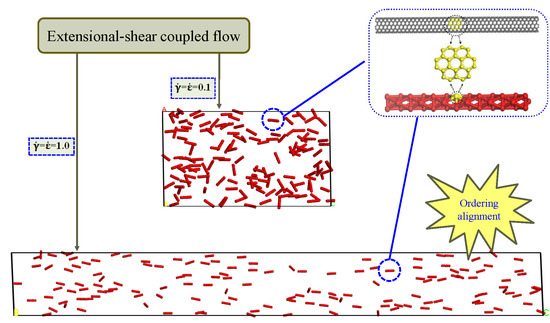Orientation and Dispersion Evolution of Carbon Nanotubes in Ultra High Molecular Weight Polyethylene Composites under Extensional-Shear Coupled Flow: A Dissipative Particle Dynamics Study
Abstract
1. Introduction
2. Simulation Details
3. Results and Discussion
4. Conclusions
Author Contributions
Funding
Conflicts of Interest
References
- Liu, Y.M.; Sinha, S.K. Wear performances and wear mechanism study of bulk UHMWPE composites with nacre and CNT fillers and PFPE overcoat. Wear 2013, 300, 44–54. [Google Scholar] [CrossRef]
- Suñer, S.; Bladen, C.L.; Gowland, N.; Tipper, J.L.; Emami, N. Investigation of wear and wear particles from a UHMWPE/multi-walled carbon nanotube nanocomposite for total joint replacements. Wear 2014, 317, 163–169. [Google Scholar] [CrossRef]
- Golchin, A.; Wikner, A.; Emami, N. An investigation into tribological behaviour of multi-walled carbon nanotube/graphene oxide reinforced UHMWPE in water lubricated contacts. Tribol. Int. 2016, 95, 156–161. [Google Scholar] [CrossRef]
- Dahiru, L.; Annas, B.A.; Samad, M.A. Tribological investigations of carbon nanotube-reinforced polymer (UHMWPE) nanocomposites using Taguchi methodology. J. Appl. Polym. Sci. 2016, 133, 44018. [Google Scholar]
- Tiana, D.; Olivier, L.; Barrau, S.; Kesavan, R.; Florent, D. Impact of carbon nanotube prelocalization on the ultra-low electrical percolation threshold and on the mechanical behavior of sintered UHMWPE-based nanocomposites. Polymer 2017, 111, 204–213. [Google Scholar]
- Gao, J.F.; Li, Z.M.; Meng, Q.J.; Yang, Q. CNTs/UHMWPE composites with a two-dimensional conductive network. Mater. Lett. 2008, 62, 3530–3532. [Google Scholar] [CrossRef]
- Christian, O.; Handge, U.A.; Prokopios, G.; Ortrud, A.; Juliane, K.; Abetz, C.; Metze, A.; Volker, A. Porous UHMWPE membranes and composites filled with carbon nanotubes: Permeability, mechanical, and electrical properties. Macromol. Mater. Eng. 2017, 302, 1600405. [Google Scholar]
- Samad, M.A.; Sinha, S.K. Mechanical, thermal and tribological characterization of a UHMWPE film reinforced with carbon nanotubes coated on steel. Tribol. Int. 2011, 44, 1932–1941. [Google Scholar] [CrossRef]
- Wang, Y.P.; Cheng, R.L.; Liang, L.L.; Wang, Y.M. Study on the preparation and characterization of ultra-high molecular weight polyethylene-carbon nanotubes composite fiber. Compos. Sci. Technol. 2005, 65, 793–797. [Google Scholar] [CrossRef]
- Kumar, R.M.; Kumar, S.S.; Kumar, B.M.; Lahiri, D. Effects of carbon nanotube aspect ratio on strengthening and tribological behavior of ultra high molecular weight polyethylene composite. Compos. Part A Appl. Sci. Manuf. 2015, 76, 62–72. [Google Scholar] [CrossRef]
- Dintcheva, N.T.; Arrigo, R.; Morici, E.; Gambarotti, C.; Carroccio, S.; Cicogna, F.; Filippone, G. Multi-functional hindered amine light stabilizers-functionalized carbon nanotubes for advanced ultra-high molecular weight Polyethylene-based nanocomposites. Compos. Part B 2015, 82, 196–204. [Google Scholar] [CrossRef]
- Tzankova, D.N.; Arrigo, R.; Cristian, G.; Sabrina, C.; Serena, C.; Giovanni, F. Advanced ultra-high molecular weight polyethylene/antioxidant-functionalized carbon nanotubes nanocomposites with improved thermo-oxidative resistance. J. Appl. Polym. Sci. 2015, 132, 42420. [Google Scholar]
- Vo, M.D.; Shiau, B.; Harwell, J.H.; Papavassiliou, D.V. Adsorption of anionic and non-ionic surfactants on carbon nanotubes in water with dissipative particle dynamics simulation. J. Chem. Phys. 2016, 144, 545. [Google Scholar] [CrossRef] [PubMed]
- Vo, M.D.; Papavassiliou, D.V. Effect of sodium dodecyl sulfate adsorption on the behavior of water inside single walled carbon nanotubes with dissipative particle dynamics simulation. Molecules 2016, 21, 500. [Google Scholar] [CrossRef] [PubMed]
- Minh, V.; Papavassiliou, D.V. Interaction parameters between carbon nanotubes and water in Dissipative Particle Dynamics. Mol. Simul. 2016, 42, 737–744. [Google Scholar]
- Wang, Y.C.; Pon, J.S.; Cheng, H.Z.; Lu, J.M.; Hsiang, W.H. Modeling of polyethylene and functionalized cnt composites: A dissipative particle dynamics study. J. Phys. Chem. C 2010, 114, 3376–3384. [Google Scholar] [CrossRef]
- Chakraborty, S.; Kumar, C.C.; Sudip, R. Morphology and dynamics of carbon nanotube in polycarbonate carbon nanotube composite from dissipative particle dynamics simulation. Macromolecules 2013, 46, 3631–3638. [Google Scholar] [CrossRef]
- Maiti, A.; Wescott, J.; Kung, P. Nanotube-polymer composites: Insights from Flory-Huggins theory and mesoscale simulations. Mol. Simul. 2005, 31, 143–149. [Google Scholar] [CrossRef]
- Kim, J.M.; Phillips, R.J. Dissipative particle dynamics simulation of flow around spheres and cylinders at finite Reynolds numbers. Chem. Eng. Sci. 2004, 59, 4155–4168. [Google Scholar] [CrossRef]
- Vo, M.D.; Papavassiliou, D.V. Physical adsorption of polyvinyl pyrrolidone on carbon nanotubes under shear studied with dissipative particle dynamics simulations. Carbon 2016, 100, 291–301. [Google Scholar] [CrossRef]
- Zhou, B.; Luo, W.; Yang, J.Q.; Duan, X.B.; Wen, Y.W.; Zhou, H.M.; Chen, R.; Shan, B. Simulation of dispersion and alignment of carbon nanotubes in polymer flow using dissipative particle dynamics. Comput. Mater. Sci. 2017, 126, 35–42. [Google Scholar] [CrossRef]
- Qu, J.P.; Chen, H.Z.; Liu, S.R.; Tan, B.; Liu, L.M.; Yin, X.C.; Liu, Q.J.; Guo, R.B. Morphology study of immiscible polymer blends in a vane extruder. J. Appl. Polym. Sci. 2013, 128, 3576–3585. [Google Scholar] [CrossRef]
- Qu, J.P.; Zhao, X.Q.; Li, J.B.; Cai, S.Q. Power consumption in the compacting process of polymer particulate solids in a vane extruder. J. Appl. Polym. Sci. 2013, 127, 3923–3932. [Google Scholar] [CrossRef]
- Yin, X.C.; Li, S.; He, G.J.; Zhang, G.Z.; Qu, J.P. Experimental study of the extrusion characteristic of a VANE extruder based on extensional flow. Adv. Polym. Technol. 2015, 35, 215–220. [Google Scholar]
- Yin, X.C.; Li, Y.; He, G.J.; Feng, Y.H.; Wen, J.S. Dispersion of CNTs in UHMWPE by melt mixing dominated by elongation stress. Polym. Int. 2018, 67, 577–587. [Google Scholar]
- Wang, J.X.; Cao, C.L.; Yu, D.S.; Chen, X.D. Deformation and stress response of carbon nanotubes/uhmwpe composites under extensional-shear coupling flow. Appl. Compos. Mater. 2018, 25, 35–43. [Google Scholar] [CrossRef]
- Wang, J.X.; Cao, C.L.; Chen, X.C.; Yu, D.S.; Chen, X.D. Phase behavior and alignment transition of ultra high molecular weight polyethylene/polyamide 6 blends under extensional and shear flow. Comput. Mater. Sci. 2018, 149, 21–27. [Google Scholar] [CrossRef]
- Kunsil, L.; Jun, L.H.; Jae, Y.S.; Seung, K.Y.; Chong, R.P. Determination of solubility parameters of single-walled and double-walled carbon nanotubes using a finite-length model. RSC Adv. 2013, 3, 4814–4820. [Google Scholar]
- Matin, M.L.; Daivis, P.J.; Todd, B.D. Comparison of planar shear flow and planar elongational flow for systems of small molecules. J. Chem. Phys. 2001, 115, 5338. [Google Scholar] [CrossRef]
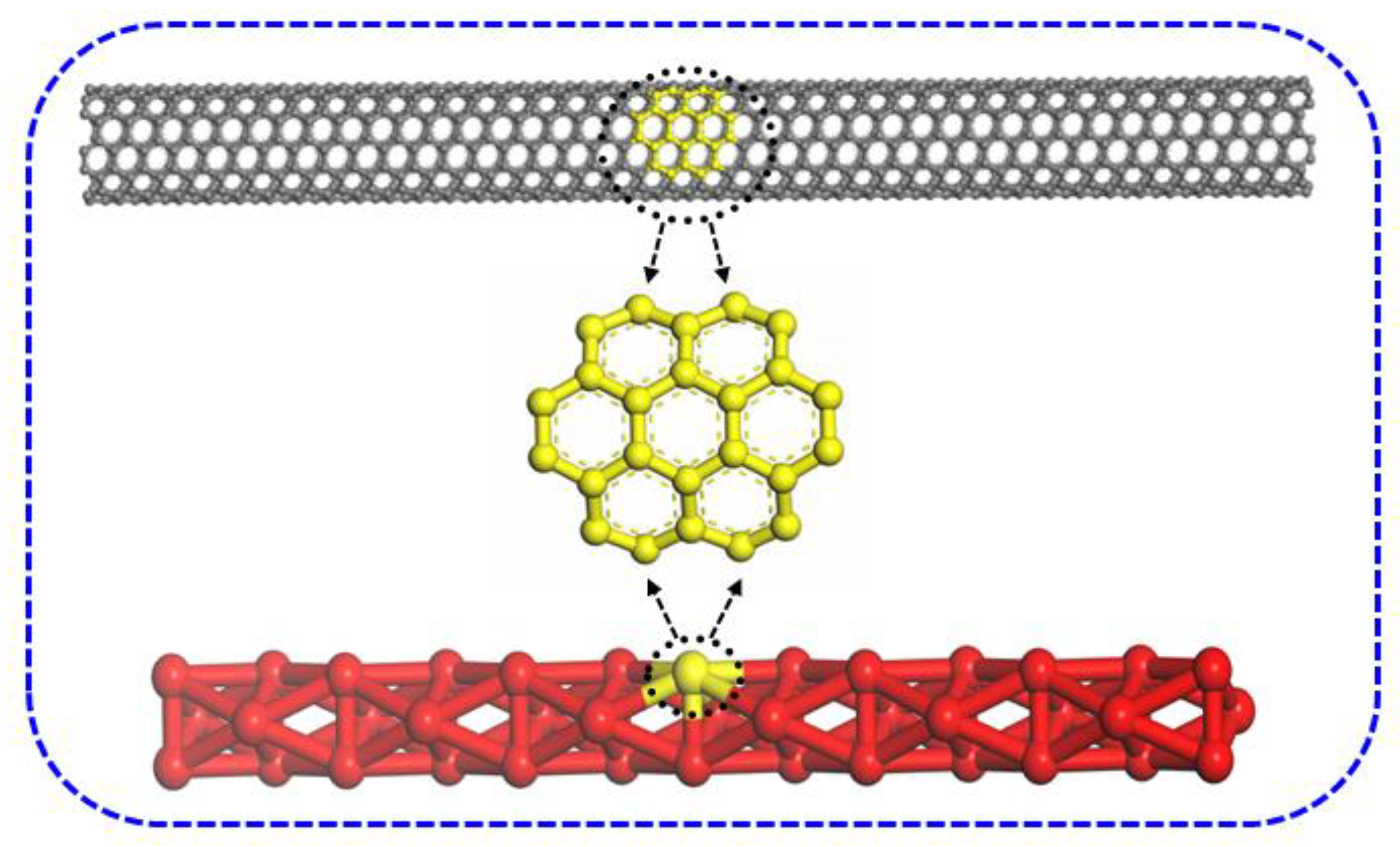
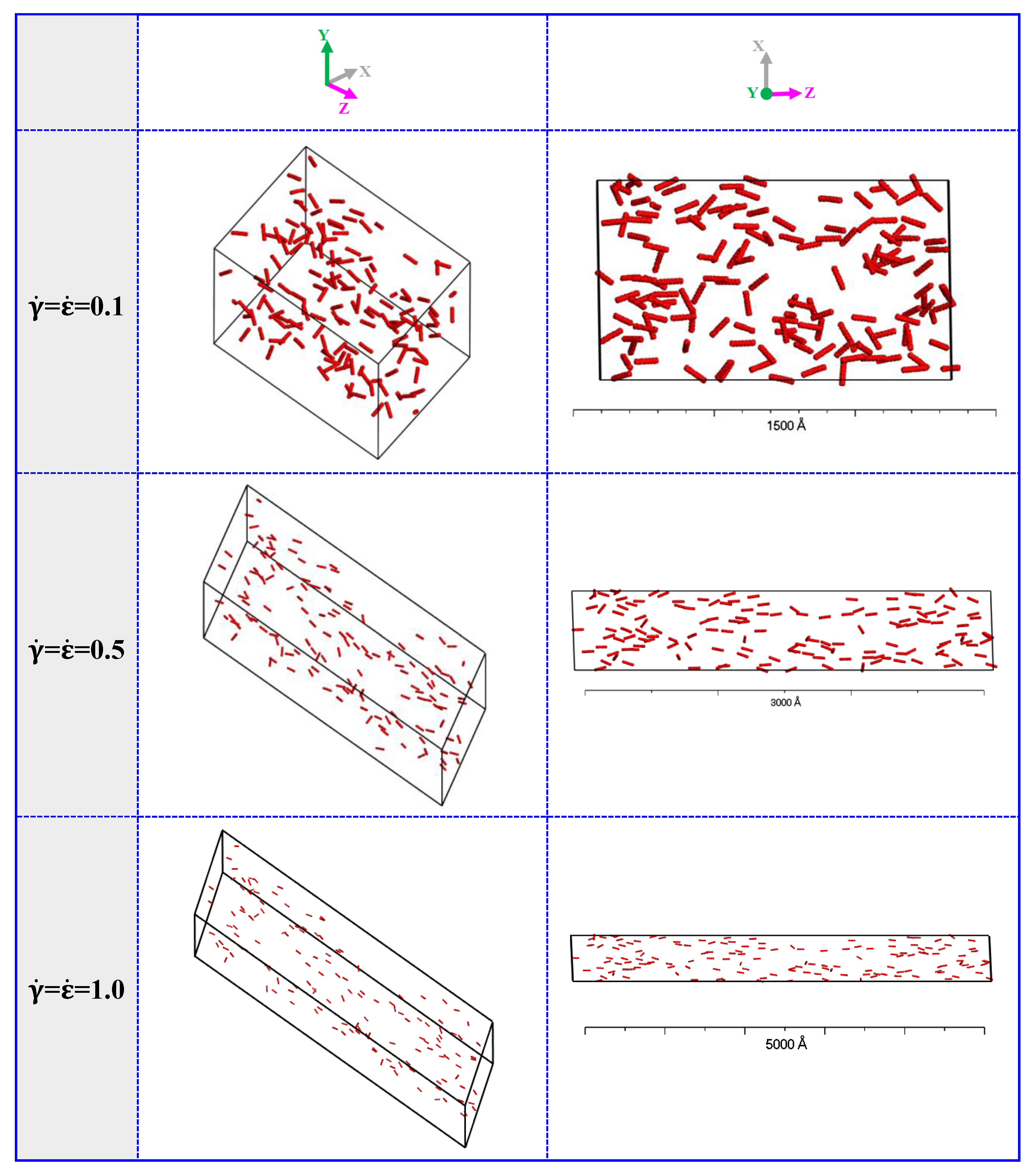
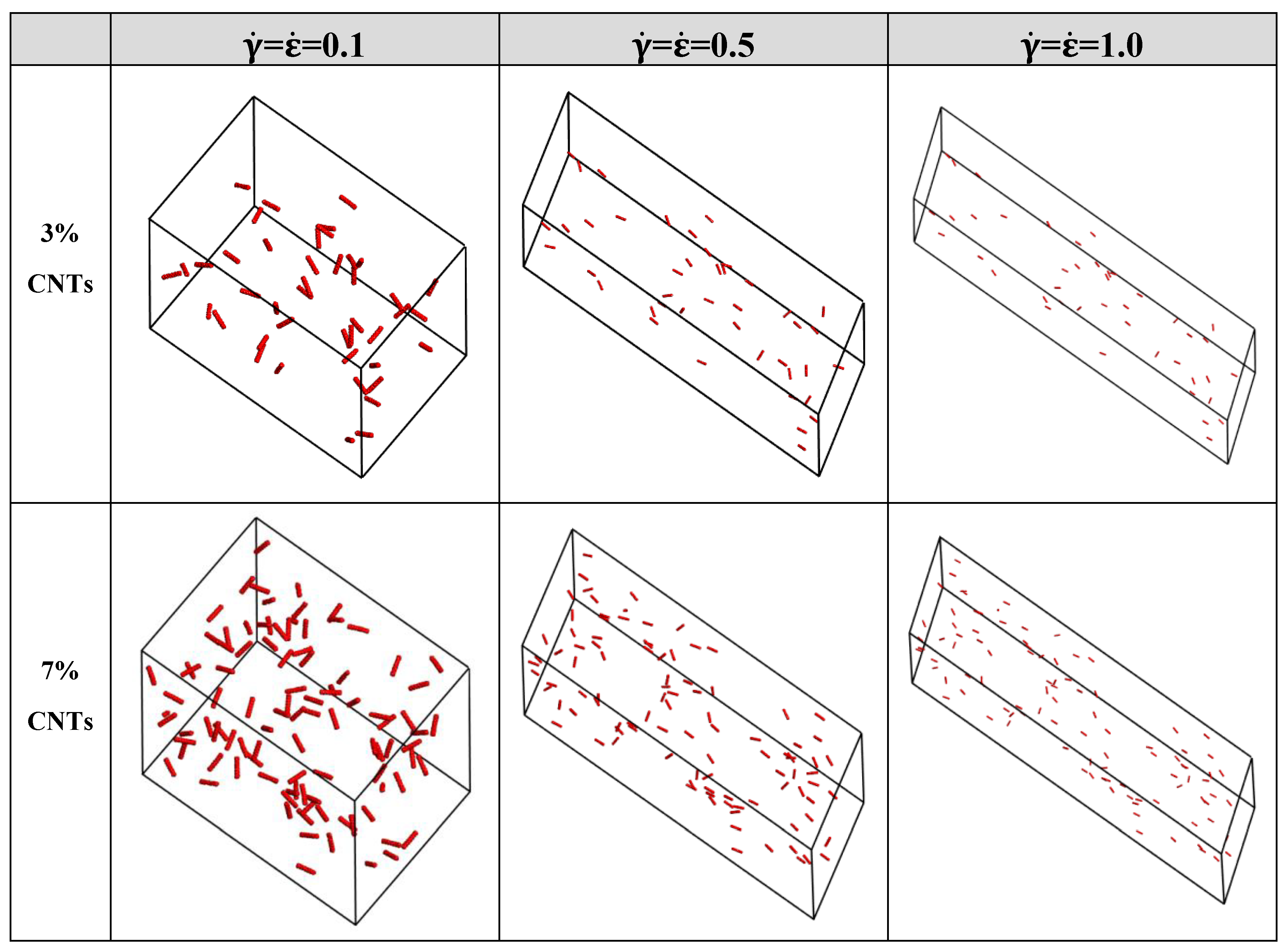
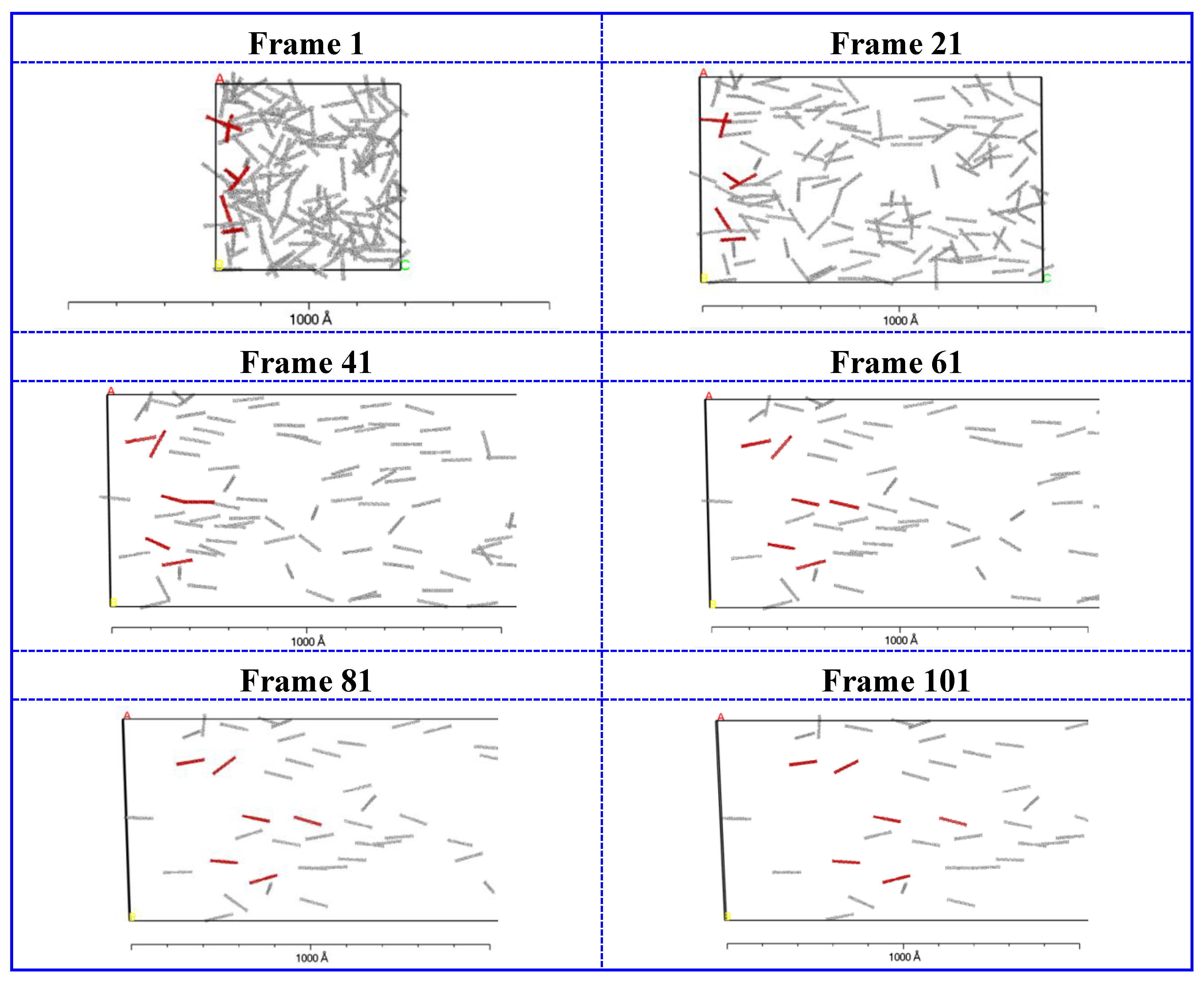
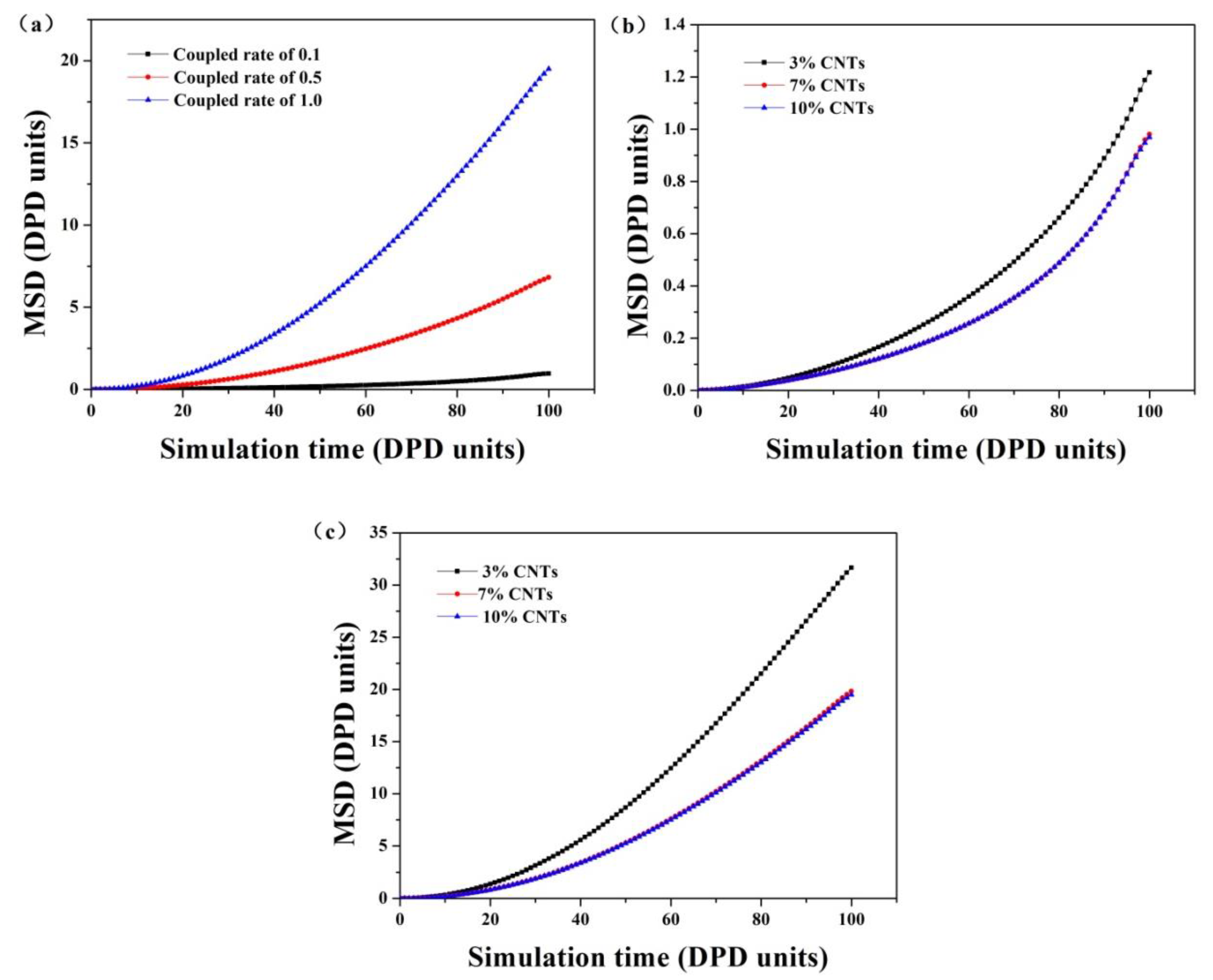

© 2019 by the authors. Licensee MDPI, Basel, Switzerland. This article is an open access article distributed under the terms and conditions of the Creative Commons Attribution (CC BY) license (http://creativecommons.org/licenses/by/4.0/).
Share and Cite
Wang, J.; Cao, C.; Chen, X.; Ren, S.; Chen, Y.; Yu, D.; Chen, X. Orientation and Dispersion Evolution of Carbon Nanotubes in Ultra High Molecular Weight Polyethylene Composites under Extensional-Shear Coupled Flow: A Dissipative Particle Dynamics Study. Polymers 2019, 11, 154. https://doi.org/10.3390/polym11010154
Wang J, Cao C, Chen X, Ren S, Chen Y, Yu D, Chen X. Orientation and Dispersion Evolution of Carbon Nanotubes in Ultra High Molecular Weight Polyethylene Composites under Extensional-Shear Coupled Flow: A Dissipative Particle Dynamics Study. Polymers. 2019; 11(1):154. https://doi.org/10.3390/polym11010154
Chicago/Turabian StyleWang, Junxia, Changlin Cao, Xiaochuan Chen, Shijie Ren, Yu Chen, Dingshan Yu, and Xudong Chen. 2019. "Orientation and Dispersion Evolution of Carbon Nanotubes in Ultra High Molecular Weight Polyethylene Composites under Extensional-Shear Coupled Flow: A Dissipative Particle Dynamics Study" Polymers 11, no. 1: 154. https://doi.org/10.3390/polym11010154
APA StyleWang, J., Cao, C., Chen, X., Ren, S., Chen, Y., Yu, D., & Chen, X. (2019). Orientation and Dispersion Evolution of Carbon Nanotubes in Ultra High Molecular Weight Polyethylene Composites under Extensional-Shear Coupled Flow: A Dissipative Particle Dynamics Study. Polymers, 11(1), 154. https://doi.org/10.3390/polym11010154




